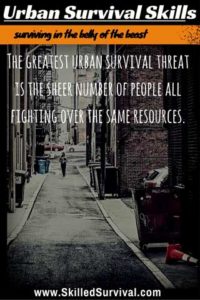
Important Urban Survival Skills To Survive In A Lawless Society
Because urban survival scares the hell out of me.
Too many people living too close together…
But that’s why we must prepared for it.
Don’t run away from what scares you…
Stare it down, and prepare!
TOPICS IN THIS GUIDE… ↓(click to jump)
- What It IS Vs. NOT
- Getting Home…
- Rendezvous Points
- Hunker Down or Bug Out
- Planning and Preparation
- Get To Know Your Area
- Scavenging For Resources
- Situational Awareness
- Staying Fit & Ready
- A Post-Disaster World
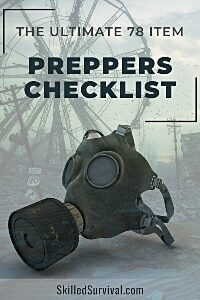
Want a free 78 item bug out bag checklist?
Enter your email below to instantly download this Complete Checklist PDF. No purchase necessary. 👇 👇What It IS and What It’s NOT
Urban survival skills are different from wilderness survival skills.
So let’s start by agreeing on “What Urban Survival Is” and “What It’s Not.”
The definition of Urban Survival differs slightly depending on who you ask.
Many take it to mean your “day-to-day city survival and safety measures” – a.k.a. “street smarts.”
But for us, I define it as follows:
The skills, tactics and ability to survive a widespread prolonged disaster while remaining in a densely populated urban environment (even if it’s just for a few days).
Urban survival is having the ability to tough it out in the belly of the beast.
Surviving a world-shattering event from within the heart of a dangerous city takes an entirely different mindset.
It also takes a particular set of survival skills, tools, and plans to stay alive.
Now, even if you don’t live or work in one of the high-population counties, you may have a family member who does.
Or maybe you occasionally visit your kids, friends, or relatives in a nearby high-density city.
The bottom line is:
If SHTF happens and you live in a city or are just there for a short visit, do you have the urban survival skills and knowledge to hunker down and survive?
Do you know how to successfully transverse such an environment?
↓ 5 Critical Urban Survival Skills to Learn Now
Getting Home…
When a disaster strikes, you’ll first want to get home (unless your home was destroyed).
Why? Because that’s where you’ll keep the bulk of our survival gear and resources.
They don’t do you much good unless you can’t get home first.
You should assume you won’t be home when disaster strikes.
You might be…but you shouldn’t assume that.
This assumption helps you prepare for THAT scenario.
And that’s why you need a fully stocked Get Home Bag.
Now, this is very different from a “Bug Out Bag” (BOB).
A BOB tends to be a large backpack stored at home and chalked full of every piece of survival gear imaginable.
It’s used for escaping danger post-disaster.
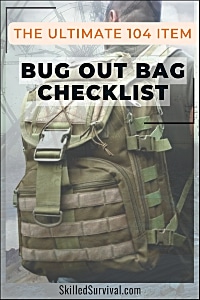
Want a free 104 item bug out bag checklist?
Enter your email below to instantly download this Complete Checklist PDF. No purchase necessary. 👇 👇A “Get Home Bag,” by comparison, is small, lightweight, and straightforward.
You should have at least one of these.
But having several dispersed in strategic areas makes sense.
One for the car, one for the office, one for the boat, one for the RV, etc.
A get home bag should contain specific resources to get back to your home base FAST.
Here are the most common items found in a get home bag:
- Spare Cash
- Everyday Carry Knife
- Maps (of the city and surrounding areas)
- Military Compass
- Everyday Carry Flashlight
- Small First Aid Kit
- Hand Crank Radio
- Protein Bars
- Water and Portable Water Filter
- Lockpicking Set
The point of a Get Home Bag is to help you get home!
It’s the basic survival gear that will give you a bit of an edge when you’re away from your home base.
↓ Get Home Bug Out Bag for Urban Survival
Rendezvous Points
Great, now that have a Get Home Bag, what happens if your home base is destroyed or unsafe?
- Do you have a backup rendezvous location?
- Have you shared this location with your loved ones?
When you are trying to survive an urban emergency, you might not have the opportunity to call your family and friends to arrange a meeting place.
- The kids might be at school.
- Your significant other may be at work across town
- You might be at the dentist.
It’s better to plan ahead and specify a rendezvous point.
But it has to be somewhere memorable.
This does not work if everyone forgets where the meeting place is.
You can choose landmarks, schools, or someone else’s house (if you trust them).
Just make sure everyone is on the same page.
And even practice a few rendezvous drills at this location.
Hunker Down or Bug Out
OK, this is the next big decision you must make.
The desire to get as far away from the city in a prolonged disaster is natural.
But not an urge you should follow in every circumstance.
When you get home, check the news and talk to your neighbors to gather more information.
There are some considerations to take into account:
- What is your emergency food stock looking like?
Depending on how much food and water you have stocked up, you may be able to survive at home longer.
The better your stockpile, the higher your chances of survival.
- How serious is the disaster or emergency?
If it’s a shorter term localized, natural disaster you’ll probably be able to rid things out.
If it’s dangerous and forecasted to continue that way, maybe your best option is to grab your stocked bug out bag and go.
OR, it could be a severe (but temporary) emergency, so bugging out might be a rash decision.
- Are government institutions still functioning?
Without police officers, firefights, paramedics, and EMTs, things will get nasty quickly.
Of course, unanticipated things will happen.
And they tend to occur more frequently during emergencies and disasters.
Some unforeseen events may sway your decision.
It may force you out of the city or trap you within your own home; expect the unexpected.
You need to plan and decide if it makes more sense to bug in or out.
↓ Bug-In VS Bug-Out
Urban Survival Planning and Preparation
Let’s assume you decide it’s best to hunker down.
The real survival threat in an urban setting is the sheer number of people fighting over the same resources.
So to survive such an environment, we will primarily focus on the following two skills:
- Avoiding Others
- Scavenging Resources
If you can limit your exposure to others and scavenge essential resources, your chances of urban survival go up significantly.
Avoiding Others – Staying Put
Avoiding others will be a real challenge in a dense city.
But staying hidden in your home or apartment is the easiest way to accomplish this.
And the only way to do that for an extended period is to stockpile.
I won’t go into extreme detail here about stockpiling (you can read more about it here).
But you need to stock food, water, medical supplies, etc.
A note of caution:
Don’t tell your neighbors or even friends about your stockpile.
Unless you’re OK with sharing your stock resources when SHTF.
So limiting the amount of exposure to others by hunkering down is a good first step.
But if you’re dealing with a prolonged disaster, you’ll be forced to venture out for replenishment at some point.
Avoiding Others – Urban Transportation
Naturally, others will notice if you jump in your car and put the pedal to the metal.
But more often than not, roads will be jammed up.
This can be a serious obstacle for someone determined to get back to home base or trying to move about the city.
Cars and trucks are the hardest to get around amid chaos.
Motorcycles and scooters are more nimble and can dart/weave through thick traffic and tight roadways.
Bicycles are another quick way of getting around in an emergency.
They are particularly handy in the case of an EMP.
Why? Because they don’t have any electronics in them.
However, with all of these options, you’re highly exposed.
Exposed to gangs, thieves, or a looter who all may have gunfire.
So evasion is paramount when exposure becomes risky.
↓ Urban Survival: Improvised Shelter During SHTF
Going by foot is preferred once cars, scooters, and bikes become a liability.
Because you can move quietly and efficiently.
Unfortunately, many large cities sprawl, so you could have a very long distance to cover.
Miles could take days if remaining hidden is required.
Darting through small buildings, a basement, or rooms to provide hidden paths can work.
However, if you don’t know the city well, you may be evading right into a bad guy’s lair.
Cities have too many people in them to remain undetected for a long.
So you also need to have a self-defense plan and be ready to take immediate proactive action.
Firearms are loud but effective, so equip yourself with a suppressor.
Melee weapons are quieter but less efficient.
I plan to have both options with me at all times.
And use the one that seems most appropriate for any given situation.

Want a free 78 item preppers checklist?
Enter your email below to instantly download this Complete Checklist PDF. No purchase necessary. 👇 👇Get To Know Your Urban Area Well
People who live and work in urban environments should know their area intimately.
Take multiple different routes to and from work each day to explore new areas.
Find back alleys and shortcuts.
Buy some detailed maps of the city and surrounding areas (keep these in your Get Home Bag).
Study these maps.
Learn them now, so you’re not fumbling with them later when the lights go out and anarchy breaks loose in the city.
Urban survival includes learning how to move about a city undetected, like a ninja.
Use gray man tactics to blend in and not stand out.
Traveling over rooftops or sewer systems becomes a major advantage.
You should start practicing these routes today to move secretly throughout a city.
Here’s a video that provides several ideas on traveling and scavenging in an urban survival situation.
↓ US Marine shows how to survive in an urban environment
Scavenging For Resources
Moving about undetected is key to avoiding conflict.
But where are you going and why?
You’re scavenging.
Finding useful resources in an urban environment may seem like a simple process.
Just dart off to the nearest Walmart or Target, right?
The problem with these public locations is that they are obvious.
Everyone already knows about these locations, and they will be looted early in a urban disaster.
So you need some new ideas.
Some good locations where the masses won’t be looking (at least initially).
You want to focus on places the masses have never thought of.
Places include distribution centers, manufacturing sites, schools, and construction sites.
Your odds of scoring a few precious resources increase significantly if the masses haven’t been there yet.
The main resources you’re going to want are:
- Water
- Food
- Medical Supplies
- Tools and Gear (such as lockpicking)
Also, if you’re a skilled survivalist, you’ll know how to turn what looks like junk into a useful survival item.
So keep that in mind when scavenging.
The following two videos provide several examples of less well-known urban survival locations:
↓ After the Collapse: 10 Urban Survival Strategies (Part 1)
↓ Urban Survival: After the Collapse (Part 2)
Practice Situational Awareness
Situational awareness is the urban survival skill you need to focus on and develop.
Your choices are determined by how well you’ve honed your situational awareness.
Using your instincts and constantly scanning your environment for evidence of trouble will help you to make wise survival decisions.
Often it’s not the strongest or most aggressive who wins.
But the one who makes better choices based on what a situation calls for.
The bottom line is:
A lot of violence could be prevented if more people had better situational awareness.
To learn more, watch this video focusing on urban situational awareness skills.
↓ Urban Survival Series – Situational Awareness

Want a free 104 item bug out bag checklist?
Enter your email below to instantly download this Complete Checklist PDF. No purchase necessary. 👇 👇To Trust Others or Not
Helping your neighbors can be incredibly rewarding.
Sharing your emergency food stockpile, ammo, or even a useful survival tip can earn you an ally during tumultuous times.
You watch their back, and they will watch yours.
It is a symbiotic relationship that benefits both parties.
Besides, having survival friends is nice for the company.
However, don’t be too trusting, or you might end up dead.
Even if it is someone you have known for years and consider a close friend, it is never a good idea to show someone where you keep your survival stash.
Use diversion safes to keep your most valuable items hidden.
Revealing valuable food, water, weapons, or ammo supplies to someone might present an unnecessary temptation.
It would suck to wake up one morning and find out your “buddy” Scott skipped town with all your ramen noodles and shotgun shells.
Be conservative with your trust.
Do not just give it to just anyone.
If there is a big bad cue ball meth-head living down the hall, you can go ahead and assume you are better off without him.
Have some common sense.
There is also the option not to trust anyone at all.
You do not necessarily need other people to survive (although it does make it easier).
Sticking just to yourself makes life a little simpler, you just need to be sure you have the ability to do so.
The lone wolf lifestyle certainly has its advantages.
Personally, I take the middle ground.
I trust with extreme caution.
The two criteria for me to trust someone is:
- They are nearly as prepared as me BEFORE the world goes to shit.
- They pull their own weight.
If they have these two qualities, I will consider building a relationship with them in preparation for SHTF.
But building a new relationship mid-disaster is like playing Russian roulette.
Not recommended unless it’s truly your only option.
↓ Urban Survival Secrets: 90% Don’t Know This ↓
Stay Fit, Stay Trained
If you are trying to make your way back home within a city, you must travel through dangerous territories (probably by foot).
Police barricades, gridlocked traffic, or destruction debris will jam roadways.
And along the way, you may have to fight.
So it is pertinent to stay in shape and even train yourself physically for such an event.
Long walks, hikes, or runs are great ways of keeping fit.
But it’s also great practice for traveling by foot.
Having travel endurance is key to urban survival.
You should practice moving quickly and with urban evasion techniques.
Thrill sports such as rock climbing, bouldering, and free running are great for toning your core and upper body muscles.
This will prepare you to climb building ladders and scramble between rooftops.
Mostly you need to be able to move throughout a city with minimal visual exposure.
Martial arts are particularly useful.
Because, on top of being great exercise, they are tried and tested methods of self-defense.
If you ever find yourself in a violent riot or a looting frenzy, there may arise the necessity to fight as opposed to flight.
IF you are a trained martial artist, you will be ready for that.
Living In A Post-Disaster World
It is not going to be easy.
When the dust finally settles and the hectic mayhem subsides, there will be a severely damaged society to cope with.
Depending on the destruction’s severity, there may be an extended period of “toughing it out.”
It could be weeks, months, or years before life starts returning to normal.
You may have to go without running water, electricity, and essential services like garbage removal.
Locate some ‘alternative’ water sources ahead of time.
Purifying water will become a very necessary survival skill.
So get some water purification tablets ahead of time.
Because the fight over scarce resources will drive the chaos.
If resources continue to be scarce, escalation will ensue.
People will go from fighting over resources to killing for them.
The most important step is survival.
And if you keep your wits and prepare yourself with these steps, you will be ready to cope with just about any urban survival scenario.

Prepare, Adapt & Overcome,
P.s. - I just found out 2 out of 3 Americans don’t feel prepared for a 3 day disaster!!!
I guess this goes to show how modern society continues to embrace ‘living a fragile life.’ What’s crazy is… it’s so easy to fix.
To make sure YOU have the basics, watch our FREE training on “10 Simple Steps To Basic Preparedness” that shows you HOW.
Nothing crazy here… this isn’t doomsday prepping... just the basics every responsible adult should have before a disaster strikes.Why You Can Trust Skilled Survival...
Go here now to review a full breakdown of:
- Who We Are
- Our Credentials
- Our Mission
- & Product Recommendations...
Here are a few highlights of our teams credentials & certifications:
- Certified Member of a Mountain Search & Rescue Organization
- Plant Emergency & Safety Leader for a Major Food Manufacturer
- Member of the 10TH Mountain Division Hut Association
- Certifications: Avalanche 1, WFR, CPR
- Official Gear Tester for Numerous Outdoor Gear Companies
- Countless Multiday Backpacking trips into Remote Wilderness
- Bachelor's Degree In Mechanical Engineering
- Bachelor's Degree In Civil Engineering
- Bachelor's Degree In Biomedical Engineering
"It takes 20 years to build a reputation and five minutes to ruin it." - Warren Buffett
We're fully aware that trust is NOT something you GET but is EARNED.
And we'll continue to earn YOUR trust through our forthright and honest approach with each new Blog Post, Guide & Product we create...
P.s - I just took this FREE 60-second 'Readiness Score Quiz'👇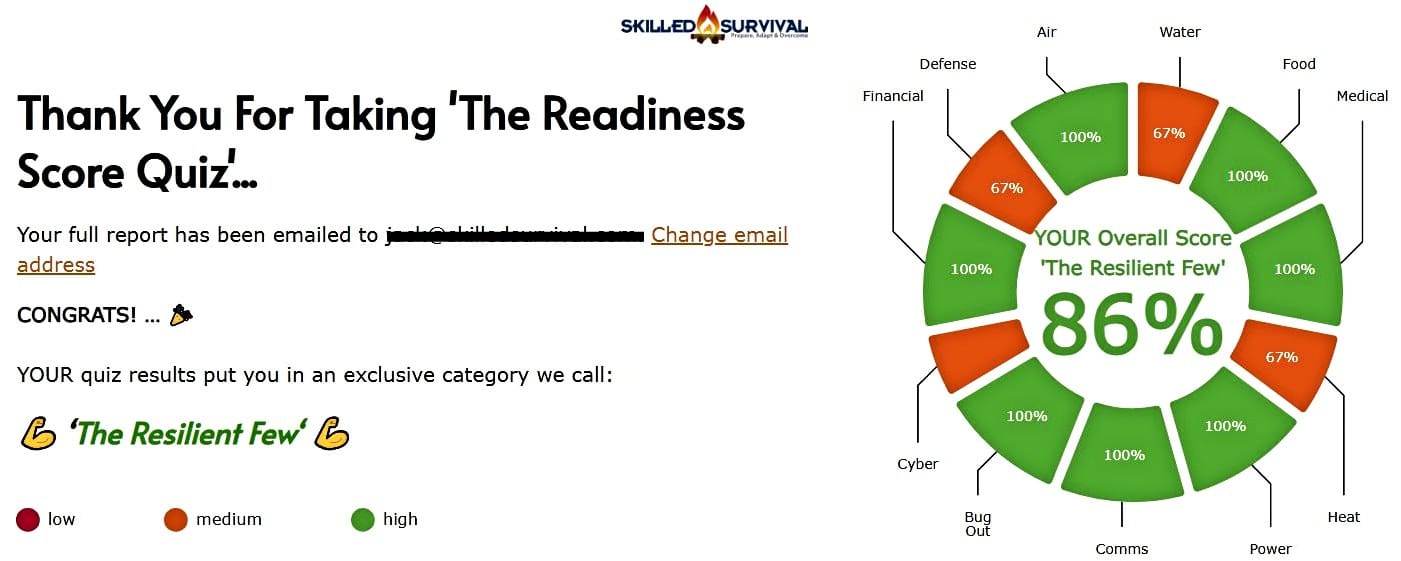
AND... I've still got a few gaps in my preps...🤔 But at least, I'm not part of 'The Fragile Masses'. 👍 Find out where YOU stand by answering a few questions...
Top Image Source
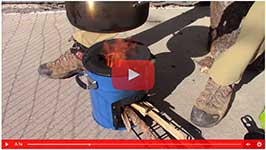
Recommended Reading
Survival Pack: How To Build One NOW (before SHTF)
A complete list of critical items that need to be in your survival pack before heading out into the wilderness.
Survival Packing List: Best For An Evacuation
Everyone needs a survival packing list to organize their escape. That way you won't regret leaving something critical behind.
Wild Edible Plants: The 13 Best Ones ANYONE Can Find
Discover the best wild edible plants you can find and eat nearly anywere. Knowing and identifying these wild edibles could save your life.
How To Make Catfish Bait: My Grandpa’s Ultimate Recipe
I want to share with you what I consider the best catfish bait recipe. Here's how to make stink bait that will get the catfish to bite.
Paracord Projects: 17 Useful Survival Tools You Can Make Today
I share the best paracord projects that are both fun and useful. By doing these crafts you'll always have lifesaving cordage on hand.
Survival Skills: The Ones Everyone Should Master
The best survival skills will keep you alive even in extreme conditions. 1. Water 2. Shelters 3. Fire 4. Navigation 5. Signaling 6. Medical





